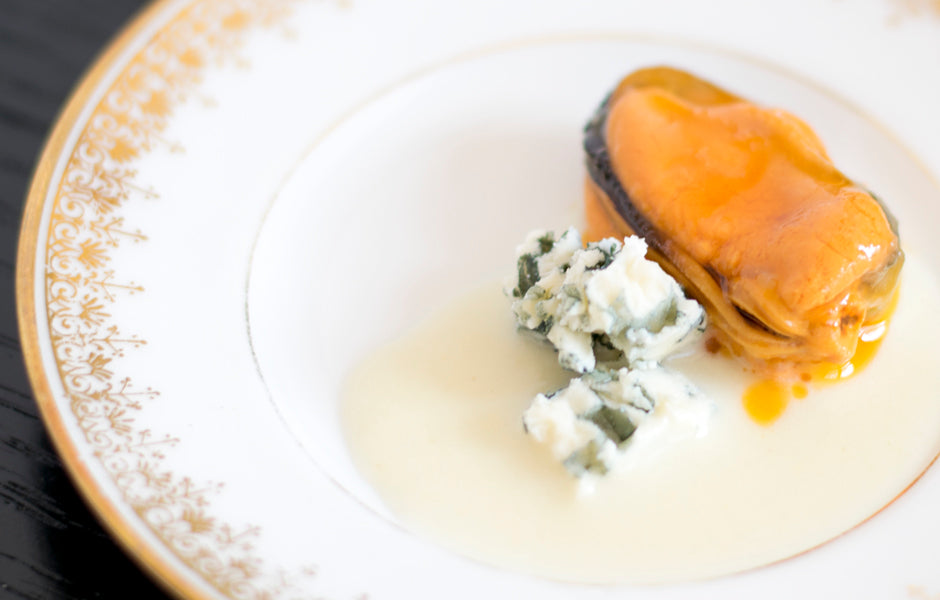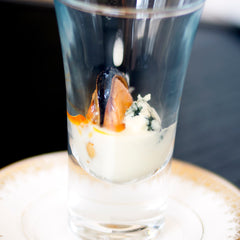---
Our attempt at a recipe by chef Seamus Mullen of Tertulia, seen here open-faced for your viewing pleasure. We toasted the bread because toast is delicious and makes everything better. You can also try chopping up the guindillas and the egg to make smaller, pintxo-sized bites for parties and general snacking, or just to mix in both with the tuna salad concoction, contrary to the directions below.
Total Time (preparation and cooking): 15-20 minutes
Servings: one significant sandwich, a couple medium-sized sandwiches, several tiny sandwiches
1. Ideally, you've hardboiled your eggs already, but if you haven't, do that now why slicing and toasting the bread.
2. Combine the tuna and capers and olive oil and all the chopped and diced ingredients with the mayonnaise, except the eggs and guindilla peppers. Maybe add a little more mayonnaise.
3. Layer the tuna on the slices of bread.
4. Top the tuna with slices of the eggs and guindilla peppers in an appealing way.
5. Eat.
---
It's been well documented that anchovies and sardines are an excellent, affordable source of omega-3s and vitamin D. If that wasn't enough to convince you to give high-quality versions of these small fish a chance, consider the environmental impact of just what it takes to bring them to your table. As April Fulton for NPR reports, "... to catch a metric ton (about 2,200 pounds) of sardines or anchovies, it takes about 5 gallons of fuel. In contrast, to get the same amount of lobster or shrimp, you'd burn an average of 2,100 to 2,600 gallons of fuel."
To read more, please visit The Salt on NPR.org.
Another delicious pintxo without the prep. Just open a jar of marinated grilled artichokes, a jar of Cantabrian anchovies, and add a dash of piment d'Espelette, paprika, or other spice that in your best judgement would work pretty well.
Total Time (preparation and cooking): 5 minutes (if that)
A flavorful dish that's an enjoyable combination of octopus in olive oil and fresh ingredients. Use as much are as little octopus as you'd like, and experiment with different spices if you want to add bit more... spice.
Total Time (preparation and cooking): 15-20 minutes
Ingredients
3 tins - Octopus in Olive Oil (use more or less based on your own judgement)
1 onion
1 red pepper
1/4 cup dry white wine
2 tablespoons tomato paste
2 plum tomatoes (peeled and seeded)
salt & pepper (and other spices, if you so desire)
Directions
1. Chop the onion and red pepper and throw them in a frying pan over low heat.
2. Add the octopus.
3. Add the dry white wine, the peeled and seeded tomatoes, and the tomato paste.
4. Cook all the the above for about 10 minutes; if too dry, add a small amount of water.
All that's necessary for this tapa are three ingredients.
Total Time (preparation and cooking): about 10 minutes
Ingredients
Cantabrian Anchovy Fillets
Extra Virgin Olive Oil
Fresh, Crusty Bread
Directions
1. Slice the bread and brush on a light coating of olive oil.
2. In a grill pan or on a grill outback if you're having a barbecue, toast the bread until you start to see grill marks and the slices look delicious.
3. Top each slice with two anchovy fillets. Eat.
Our manzanilla olives received mention in April's issue of Bon Appétit. If I lived in Paris I'd try and get my olives from La Tête Dans les Olives, too, but right now the airfare is a bit prohibitive. "A close second, without the jet lag," may become our new tag line.
Chef Inaki Aizpitarte may not currently have the name-recognition of celebrity chefs, but as writer Christine Muhlke states, "While few outside of the foodist fishbowl know “Ee-NYA-kee,” he is the man nearly every big-name male chef in the world under 40 (or 65) wants to look like, cook like, and be like."
Scroll down to Inaki's Tapas Pantry to check it out (our anchovies and guindillas aren't too shabby, either):
How Inaki Aizpitarte, of Le Chateaubriand, Paris, Does Lunch at Home

We tried our own take on a recipe presented by Pepe Solla at the Salón de Gourmets in Madrid last week. The gastronomic trade fair features food producers, winemakers, chefs, and loads of delicious food and drink.
For the ajoblanco recipe, we tried one found on epicurious.com posted by Bon Apétit Magazine, adding a bit of green apple to the traditional white gazpacho. To maintain a Spanish theme, try a cabrales blue cheese, but any variety you enjoy will probably do just fine. The mussels in escabeche combined with the flavor of the blue cheese and the ajoblanco seemed to work out well, as I ate all the models for the photographs.

We served them in shot glasses to keep the proper ratio of mussels to cheese to ajoblanco. Also, because it was easiest.
This recipe from Foods from Spain is relatively easy and is a good choice if you're in an Olympics via Spain mood. Or something.
Russian Salad recpie from Foods from Spain

Judy Walker of The Times-Picayune queried some chefs and foodies to discover what foods deserve more love for Valentine's Day. Of course, anchovies get the love they deserve amongst the other foods who do not usually get the love they deserve. Or something.
One of the participants provides a good suggestion for anchovies at home, as he, "sautés canned anchovies in olive oil with garlic, adds parsley and then stirs in pasta or florets of steamed cauliflower (another food that needs more love, he said). The anchovies "provide body and flavor you wouldn't get otherwise."
Read more at nola.com.
If you're looking for traditional Spanish recipes that (allegedly) anyone can prepare, try The Family Meal: Home Cooking with Ferran Adria. I've yet to sample anything from the book, though odds are good there are some delicious dishes that'll come out of it.
The Family Meal: Home Cooking with Ferran Adria
Here's a more time-intensive recipe by Pepe Rodriguez Rey for Foods from Spain. Click the photo for the full recipe. If you give it a try, let us know what you think. I've yet to convince someone to attempt it so I can give it a try.
Marinated Sardines with Strawberry and Cheese Sauces
